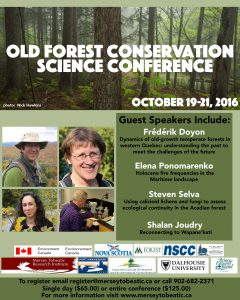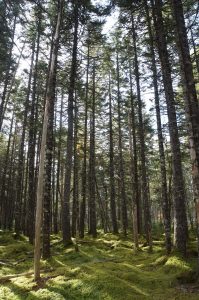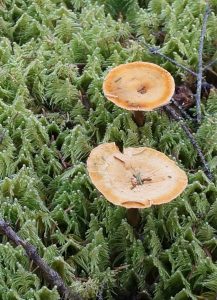I attended the MTRI Old Forest Conservation Science Meeting at Debert this past week, anticipating that it would be a good experience and it was. I am guessing the attendance was about 80 people, from all walks – foresters, rangers, small wood lot owners, company men, academic and government scientists, people from conservation oriented NGOs such as NS Nature Trust, the Nature Conservancy of Canada, CPAWS and CCNB, and others without specialized interests but with a common interest in old forests.
 As is now not uncommon (but still not common enough), the meeting was opened with an acknowledgment that we were meeting on un-ceded Mi’kmaq territory. Appropriately, Mi’kmaq poet and scholar Shalan Joudry was asked to start it all off. We fell quiet as she sang, her hands drumming the rhythm of a heart. It was the heartbeat, she said, of the people and the land.
As is now not uncommon (but still not common enough), the meeting was opened with an acknowledgment that we were meeting on un-ceded Mi’kmaq territory. Appropriately, Mi’kmaq poet and scholar Shalan Joudry was asked to start it all off. We fell quiet as she sang, her hands drumming the rhythm of a heart. It was the heartbeat, she said, of the people and the land.
The next day, we dispersed in several directions for jaunts in the forests. It was a totally glorious day weather-wise so we didn’t begrudge being indoors on the following, rainy day to view presentations and join discussions on a wide range of topics related to old forests. Those began with Shalan talking about “Reconnecting to Wapane’kati”
I don’t want to try to report on Shalan’s talk except to cite, very imperfectly, a few of the thoughts or observations she expressed as we listened intently. “You cannot separate the people from the land” she told us; “it is who we are”, although the European immigrants managed to do it to them physically.

Dr. Elena Ponomarenko shows us how to read the forest floor to reveal past disturbances and forest types.
Shalan described the excitement she felt when she first saw a map of the Acadian Forest in Jamie Simpson’s Restoring the Acadian Forest (1st ed. 2008, 2nd Ed. 2015) and realized that the distribution of the Acadian forest corresponds closely to Wabanaki Territory (see e.g. map at Abbe Museum), the lands occupied by peoples of the Wabanaki Confederacy. Wabanaki means “People of the Dawn” and as I understand it, Wapane’kati, “Land of the Dawn”. Mi’kmaq people understood Wapane’kati as the place where people first welcome the sun on behalf of rest of the peoples of Turtle Island (North America).
What a wonderful view of this part of the world. Now I will think of it when I witness the sunrise. How better could the connection between peoples and the land be illustrated than by the occurrence a particular group of people on landscapes of a particular forest type?
The Mi’kmaq history is all of our history Shalan said. Through the choices they made, the Mi’kmaq people made the land what it was when the Europeans arrived.
Shalan described their stories as a way of teaching. She told us the Story of the Long Winter when people in a time of great abundance became arrogant, and the animals disappeared; of how they tried to find the animals and then learned from a child that they had to reconcile themselves with the land for the animals to return. The story relates strongly to our world today. Shalan talked about how the “Conversation of Reconciliation” is good for us AND for the land.
The meeting was closed with Elder Doreen Bernard of Sipekne’katik First Nation leading a Water Ceremony. Again, I could only describe it imperfectly. It was a ceremony of beauty, simplicity and inclusiveness. We were encouraged to incorporate such ceremonies in our daily lives.
These were inclusive perspectives. We were urged to understand and acknowledge the wrongs of the past so that we can collectively and more wisely move forward together to heal the earth.

Looking into the forest floor suggests this coniferous “climax” forest was preceded by a mixed or deciduous forest; and that a strong wind event, perhaps followed by fire, triggered a transformation to the forest we see today.
There was a certain unease amongst some at the meeting as there were disparate groups or individuals present who simply do not get together on “neutral ground” otherwise. I guess the extremes might be described as the “tree huggers” on the one hand, and the “industry men” on the other.
Shalan had some interesting perspectives for both parties. On the one hand she talked about reverence for Old Growth forest which tree huggers often say, rightly or wrongly, is not shared by the industry men. She also felt, possibly to the chagrin of the tree huggers, that the term or concept of “Protected Areas” conveys a sense that people and land do not belong together and suggested that perhaps we need to rethink that concept a bit.
One reason individuals with disparate perspectives got together at all at this meeting is that MTRI is a registered non-profit organization and so must stay away from the politics of forestry. So we would talk about the science of old growth forests to a large extent separately from any discussion about the politics of forest management, and entered that conversation very cautiously if at all. (Such discussions were taking place, but not collectively.)
Indeed, I learned that there has been discussion amongst some of the people attending the meeting about forming a “conservation council” to facilitate better sharing of resources and information. It seems the prevailing view was that such an organization would not get involved in the politics of forestry; it would not be an advocacy group.
While I agree there is a need for better sharing of information, I would prefer to see an organization whose primary goal is information sharing to develop within an existing organization such as MTRI rather than creating a new one.
Regardless, such an organization would leave unanswered the more challenging issue of how we open up discussion between parties that have strongly differing views of how our forests should be managed. All of the information in the world will not, on its own, open up that conversation.
 It strikes me that we might seek guidance from the Mi’kmaq to help us talk to each other. At this meeting, Mi’kmaq participants had raised issues that have caused them great suffering while being non-confrontational, and indeed challenged and urged us to move into the future together. It is along those lines that we must proceed if we are to manage our forests in a way that we can all agree is good for all of us and good for the land.
It strikes me that we might seek guidance from the Mi’kmaq to help us talk to each other. At this meeting, Mi’kmaq participants had raised issues that have caused them great suffering while being non-confrontational, and indeed challenged and urged us to move into the future together. It is along those lines that we must proceed if we are to manage our forests in a way that we can all agree is good for all of us and good for the land.
As Shalan said, we must begin a conversation of reconciliation between peoples and between peoples and the land. I would like to think the MTRI meeting had provided a first step along that path.
Thanks, MTRI and thanks, All participants and sponsors.
Each generation must make their own journey through a thick terrain.
How ever we get lost along the way, let us rejoice in the healing steps that follow.
I hope we all continue to gather at the edge of the woods where the generations before us and after us re-merge.
Prologue to Generations Re-Merging by Shalan Joudry
